Winter Audio Reference: On-Board, Consumer, and Pro Solutions
by Derek Wilson on February 3, 2005 12:05 AM EST- Posted in
- Smartphones
- Mobile
The Cards
These are the first cards that we'll be taking a look at in their categories. Other sound hardware reviews that we do will have a point of reference to this article. For onboard solutions, we'll compare against the Realtek HD audio that we're reviewing today. When we look at consumer level add-in cards, the obvious metric is the Sound Blaster Audigy 2. For professional cards, we've chosen the Echo Audio Gina3g as our point of reference for its mix of features and solid quality.
The Intel, Gina3G, and Creative mix touches on high quality, integrated, multitrack/music recording, gaming, and the consumer audio solutions. We wanted to hit all these groups in this review in order to get a feel for what each had to offer. The first solution that we'll look at is the Intel solution.
Realtek Intel HD Audio
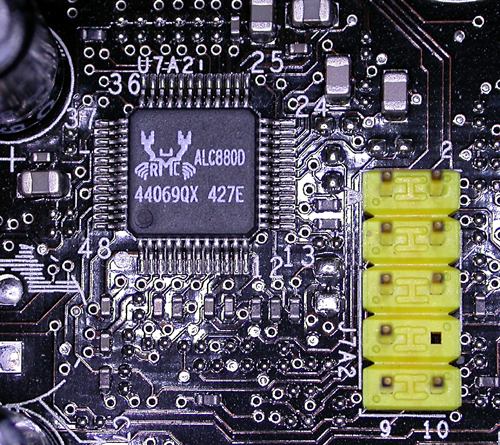
This is the Realtek Intel HD Audio codec chip.
As we can see, the Intel solution is the Realtek solution. We wanted to track down the DACs and opamps that drive the output, but finding these tiny chips on a motherboard proved too difficult a task for us. Suffice it to say that layout is key when dealing with an onboard solution. We actually plugged our Audigy in a PCI port further away from the video card, thinking we'd get better signal quality and noticed an 8dB increase in noise due to this:

This is a 1.5A low dropout positive regulator near the 3rd PCI slot on the 925XE board.
Imagine the difficulty in guarding against noise with an onboard solution if simply moving to a different PCI slot can change so much. Vendors other than Realtek are planning on coming out with HD audio compatible onboard solutions, and we are looking forward to testing those as well.
On the downside, the Realtek only has 20 bit stereo inputs, so doing a 24bit loopback is a little less than honest. The record quality of this onboard solution is less than optimal, and in very loud playback, a little noise can be heard.
Echo Audio Gina3G
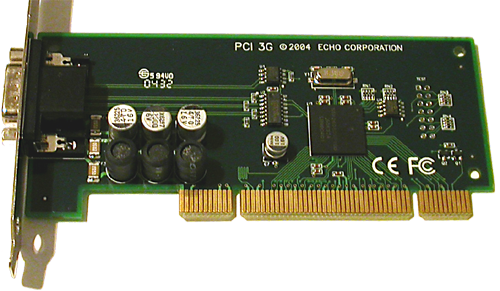
The Gina3G PCI card
The Gina3g is an entry level professional sound card from Echo Audio. Musicians on a budget are always on the lookout for a device that combines a few high quality analog inputs with a couple of coax and optical digital connections that support S/PDIF and ADAT I/O.
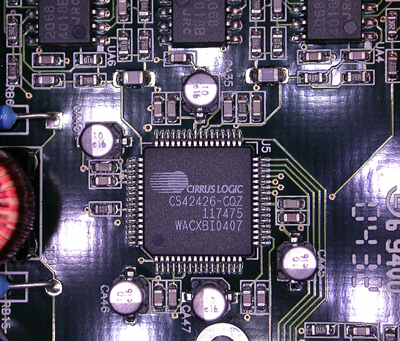
Inside the Gina3G breakout Box
This device would be a stop off on the way to something like the Lynx TwoB, or a DigiDesign ProTools solution. With the ability to record 8 digital channels at a time, 6 (highly configurable, balanced) analog outputs, and 2 universal analog inputs (accepts ¼ inch and XLR, balanced or unbalanced, and can provide 48v of phantom power), the Gina3g is targeted squarely at the end user looking to take their audio and put it on the PC. A small home studio could go the way of having a couple of rack mount devices - compressors, eqs, and an A/D - to bundle it all up and send it to the PC. The Gina would fit in nicely. There are both cheaper and more expensive solutions out there.
In any case, the reason why we are testing the Gina3g today is because its older siblings have done very well traditionally in terms of analog signal quality. We wanted to find out if Echo Audio's latest in the series still stacks up.
Creative SoundBlaster Audigy 2 ZS Platinum Pro
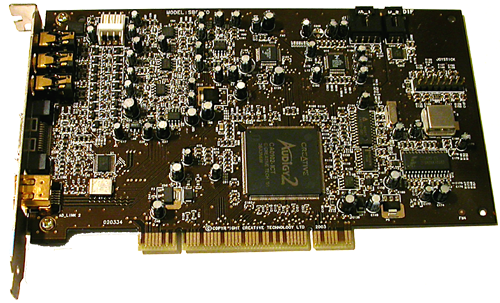
SoundBlaster Audigy 2 ZS Platinum Pro PCI Card
The Audigy is the consumer standard in sound hardware today. It is a very gamer and entertainment PC oriented solution. The Platinum Pro is a Swiss army knife of a sound card - a little of everything, but never exactly what you want. Digital playback is quality, but analog at 16-bit/44.1 kHz leaves something to be desired. Recording quality is solid, but there could be more I/O on the device if it is going to fit into any aggressive user's workflow. Lacking balanced analog I/O is a large oversight if Creative wanted to target the prosumer/audiophile. But in the end, the audigy does fit into just about every niche in which you could want a sound card. And it offers EAX Advanced HD as only Creative cards can.
Creative SoundBlaster Audigy 4 Pro
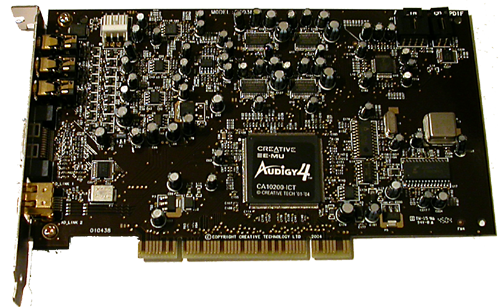
SoundBlaster Audigy 4 Pro
The SoundBlaster Audigy 4 Pro is basically an upgraded and massaged version of the Audigy 2 ZS Platinum Pro. The differences are in the quality of the DACs and ADCs used, some layout changes, and just a bit of a polish that makes the quality of the card fit the feature set better. Still offering the same gaming quality, the analog output of the card is now on par with professional level cards in some respects.
Summarizing the Differences
So, what are the key factors that are different among the contenders? Let's take a look:
-- DAC quality: the Audigy 4 has the highest quality DACs, though the Gina3G places it's DACs outside the PC in its breakout box. Here are the DACs used on the Audigy and Gina3G:
Audigy 2 DAC: 1x CS4382: 8out 114dB dynamic range, -100dB THD+N
Audigy 4 DAC: 4x CS4398: 2out 120dB dynamic range, -107dB THD+N
Gina3G DAC: 1x CS42426: 2in/6out 114dB dynamic range, -100dB THD+N
Both Audigy products use 4558c opamps with THD < .008%
Gina3G uses NJM2068 opamps with THD < .001%
-- Input quality: The Gina3G uses balanced I/O, and has the most input options. The quality of the ADCs on the Gina3G and Audigy are similar (Audigy is noisier with less THD). The Intel Audio solution only supports recording at a max of 20-bit/96kHz analog, and is noisy on recording. No pro digital recording features are enabled on the onboard solution even when lightpipe is present, so Creative and Echo have the Intel beat in digital recording as well.
-- Gaming features: The Creative solutions offer EAX 4.0 Advanced HD, which neither of the other cards can claim. Intel is able to include EAX 2.0 support along side it's DS3D and A3D support, but the Gina3G offers zero 3D hardware support or reverb API support. Included on the Gina3G is a DSP that is capable of such operations (Xilinx Spartan), but it's obviously intended for professional applications.
Other than that, the differences are in feature set and drivers. The Audigy cards offer the most in terms of "stuff" with their cards, though the Intel solution does a good job of filling in the gaps as well. Even though the Gina3G "only" supports 6-channel out on the consumer side, the fact that all 6 outputs are balanced TRS ¼ inch is a nice bonus for the musician. Depending on implementation, the Realtek solution can have optical and coax output, but Audigy and Gina3G both offer optical and coax in and out.










89 Comments
View All Comments
smn198 - Thursday, February 3, 2005 - link
For me personally what I would want is reviews of gaming perfomance since I used the SPDIF outputs and my HiFi so they all should so the same. I'd also like to know how much difference there really is between different EAX implementations and if it is true that a new SoundStorm board is coming out. I'm sure you know. Can't you just claim you forgot the NDA? ;)reidc - Thursday, February 3, 2005 - link
My main reason for a soundcard is transferring analog audio from my Turntable(remember those 12" pieces of vinyl????) to CD- or commonly referred to as "needle-drops". The higher quality DAC's and discrete components the better.When I went from my old SB-Live to turtle Beach Santa Cruz- I recevied a huge boost in quality- the drop in noise was huge.
I'd love to see how the TB SC holds up in this regard compared to the listed products.
Oh- my TB SC is currently not in a PC- as I am just getting the Intel 915 board running in a mchine. I assume by seeing the Intel HD Audio tests- I WILL be putting my Santa Cruz in.
Chris
sandorski - Thursday, February 3, 2005 - link
Yup, a wider range of cards would be nice.ottodostal - Thursday, February 3, 2005 - link
I am quit disappointed with this review as there are only so few audio cards there. There are so many of them on the market! You must definitely include M-Audio Revolution 7.1, and some card from Audiotrak Maya + Prodigy series (aka Prodigy 7.1), and Aureon 7.1 Universe or DMX 6fire from Terratec. These are of the major cards on the market and there are missing. You could also include Turtle Beach Santa Cruz, and some card from Hercules.I would also include more mid-range and maybe some even some high-en cards (like those from Aardvark or R M E or MOTU ) generally, do not concentrate on low-end cards like Audigy 2 from Creative. In graphic cards reviews you expect us to pay over 600USD for them, so why to concentrate on value cards in audio tests? BTW if you think that people are not doing such things like playing games on audio cards which cost over 800USD you are wrong :)
You should also include some external USB and Firewire cards like Audiophile USB or FireWire 410 from M-Audio (one of my friends recently brought the Audiophile USB replacing some older Audiotrak Maya and he is quit happy with it. He told that even listening to mp3 files is clearly better).
You must also include latency tests in the review and you should comment on support of main standards lide ASIO and GSIF.
DerekWilson - Thursday, February 3, 2005 - link
#13, ceefka,if you're refering to not calling Intel HD audio, it can do 24-bit/96kHz ... It just can't record at that bit rate. Playback is no problem. Of course, it's not as high quality as we would expect to see from that many bits per sample at that sampling rate.
#12, S0me1X,
The gina3g uses an external DAC/ADC which is one of the reasons we see a cleaner signal. Of course, the soundblaster uses a /better/ DAC, so we see lower noise and dynamic range even though the signal looks a lil shaky at spots.
external DACs are a very good idea.
Derek Wilson
ceefka - Thursday, February 3, 2005 - link
Any chance for one of the Terratec soundcards? I heard they're pretty good.My ideal soundcard or onboard solution should be
-96KHz/24-bit DTS/Dobly Surround and any previous standard
-optical and coaxial s/pdif input and output
-perhaps an analogue breakoutbox for simple stereo operation and additional analogue outputs.
With so many DVD-players around (even in cars), there is no need to stay in the 44.1/16 realm. 48/24 already sounds so much better than 44.1/16.
It would be nice to have onboards being taken more seriously by the manufacturers. The leads on a mobo are all quite exposed to everything else going on in there. A few efforts in shielding would probably make a real difference, even without changing the chip. I am not ready to pay for a crappy onboard solution. And don't call it HD unless it can do 96/24.
S0me1X - Thursday, February 3, 2005 - link
Best way to get quality sound out of a pc is to use an external DAC. I'm using a Benchmark DAC1 that I'm very happy with :)SignalPST - Thursday, February 3, 2005 - link
I just hope that Creative would fix the 44.1kHz resampling issue and IMD problems with the Sound Blaster Zenith sound cards thats suppose to come out sometime this year.sxr7171 - Thursday, February 3, 2005 - link
I don't see how the Audigy 4 is so much better than the Audigy 2 to recommend it over the Audigy 2. They are pretty much the same with the Audigy showing weaknesses and one strength in 24/96 D/A conversion. I guess internal computer audio is still not to be taken very seriously except for games (which the reviews sort of hints at).wrecktangle - Thursday, February 3, 2005 - link
any chance you could take a look at the m-audio revo 5.1? i've been looking for a review of this card for a long time. even a short update/comparison to the revo 7.1 would be great.on the whole, this review seems alright. kinda short though. definitely touch on recording quality in the future. maybe you could also stretch out the qualitative bit with some more music listening tests of other genres.
is it just me, or are the spectrum plots missing?